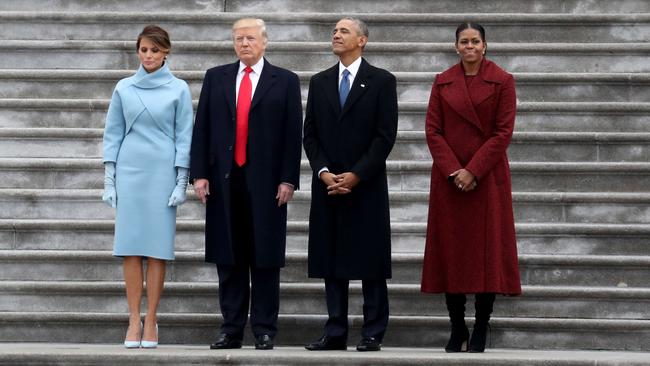Obama’s legacy in a nation divided by race
The end of Obama and the beginning of Trump raises important questions for the US.

In January last year, the presidential primaries began in the US. For the Democrats, the successor to Barack Obama looked to be Hillary Clinton. Denied the crown in 2008, it was hers for the taking eight years later. On the Republican side, 17 candidates from a range of backgrounds and experiences in government fought to be the nominee.
The presence of real-estate tycoon and reality television star Donald Trump seemed just a sideshow that distracted attention from the nomination of a vetted, establishment-approved candidate: if not Jeb Bush, then John Kasich or Marco Rubio.
Trump, however, defied the conventional rules of political engagement, savaging his primary opponents and then, after winning the GOP nomination, Clinton in the contest for the White House. Their vitriolic race rivalled that between John Adams and Thomas Jefferson in 1800, long viewed as the standard in ugly presidential bouts.
By the time it was over, Trump, to the astonishment of political commentators, had won the presidency. He had tapped into twin discontents in the American political psyche: an antipathy to the forces of globalisation that had stripped lower-income and blue-collar Americans of their livelihoods over a 40-year period, and a rejection of a vibrant, multi-ethnic society, of a “politically correct” culture exemplified by Obama.
As the first months of the Trump presidency have unfolded, a number of books have been released reflecting on the end of the Obama presidency. Two interesting works that approach this debate from different angles are Jonathan Chait’s Audacity: How Barack Obama Defied His Critics and Transformed America and Michael Eric Dyson’s Tears We Cannot Stop: A Sermon to White America.
Chait’s book is a robust defence of Obama, arguing for his place in the upper ranks of US presidents. Dyson’s is an impassioned critique of race relations in the US, spurred by events during Obama’s presidency and by thoughts on what Trump’s election means for a nation fractured along the colour line.
Chait is a regular contributor to The New Republic, The New York Times and The Wall Street Journal. In Audacity he critiques the emerging narrative regarding the Obama presidency: that of a well-intentioned centrist trying to make gains against the obstructionism of an increasingly right-wing GOP. This is the view of a president who in many respects promised more than he could deliver.
The anger that faced Obama from the right was matched by disappointment from the left and supporters who “spent most of his presidency in a state ranging from resignation to despair”. But Chait is having none of that, claiming Obama “accomplished nearly everything he set out to do, and he set out to do an enormous amount”.
Chait focuses on four key policy areas where Obama attempted to make significant gains: fixing the economy in the aftermath of the global financial crisis, healthcare, the environment and foreign policy. The case is more convincing for some than others. With the GFC unfolding as Obama took office, Chait examines how, unlike the crises that confronted George W. Bush with 9/11, or Lyndon Johnson in the aftermath of the John F. Kennedy assassination, the financial meltdown “did not invest the president with new agenda-setting powers”.
While Obama helped prevent another Depression, the political advantage, Chait argues, was minuscule. “Presidents get credit for responding to disasters, not from keeping them from happening in the first place.”
For a president to go from “Yes we can” to “This could have been worse” might be seen as a failure; however, Chait contends that Obama faced an uphill struggle. The left said the stimulus package he passed did not go far enough while the right decried the “economic fascism” that had entered the White House.
Similar problems arose with the creation of the Affordable Care Act. Advances in government healthcare had been glacial, with no major reforms enacted since the creation of Medicare and Medicaid under Johnson in the 1960s. With healthcare costs spiralling, fixing this was a key plank of Obama’s presidential campaign in 2008.
Chait argues that the passing of the Affordable Care Act in 2009, giving health insurance to millions of previously uninsured Americans, forms the centrepiece of Obama’s presidency. It “will be seen as one of the most … successful social reforms in the history of the United States”. If Trump makes good on his promise to “repeal and replace” it, however, the Affordable Care Act might just be a footnote.
In other areas, Chait strains to make his case. The chapter on foreign policy is significantly shorter than the others, as Chait argues Obama’s policies were corrective rather than transformational, hardly surprising given what was bequeathed to him by Bush.
Despite his valid criticisms of Obama’s “red line” rhetoric regarding Syria’s use of chemical weapons, this section of the book seems rushed, as if the failures of the administration need to be minimised in order to properly make the case for Obama as one of the great presidents. The Benghazi attacks, for example, which helped to hobble Clinton’s presidential aspirations, are passed over in one sentence.
The election of the first black president deepened the divide between black and white. The racial backlash to Hawaii-born Obama, led by the charge he was not really an American, was ironic given his attempts to downplay his racial image and message, moving away from the fiery rhetoric of a previous generation of black leaders such as Jesse Jackson.
Chait focuses on race in one part of Audacity. The subject is, however, the main theme of Tears We Cannot Stop. Dyson, a professor at Georgetown University, has spent decades examining race in America, particularly the intersections of race and popular culture and race and politics.
Structured as a sermon, this book reflects on race in the post-Obama era as Dyson explores the impact of racism on his own life, and where the country stands in the era of a resurgent, racially tinged nationalism.
Dyson examines more than just the Obama administration and the aftermath of the Trump election. While the book can be situated in the African-American canon of James Baldwin, Toni Morrison (who provides a cover blurb) and others, Dyson directs his narrative to a specifically white audience, addressed at various times as “beloved” and “my friends”.
Putting the reader under the interrogator’s light is a literary risk. It may for some readers prove too much of a distraction, undermining the ideas Dyson explores.
The shooting of unarmed African-American youths forms the strongest part the book, as Dyson reflects on the suspicion levelled by the state towards its black citizens. Yet his description of the police as a “metaphysical collective with a gift for racial punishment that has never viewed black folk as human beings, because the law that they are charged to enforce has never seen us as human” may be overstating the case.
The discussion of the racially charged criticism of Obama conveys the frustration many felt regarding the election of the first African-American president: far from bringing closure to a racially divided history, it instead fuelled terrible instances of racism and bigotry.
Dyson argues for a clear line between the racism that confronted Obama and the election result of 2016: “ ... there’s little real justification for Obama hate, except that he was a black man in charge of our country, and many whites wanted to take it back and make it great again. Hence the election of Donald Trump as President.”
Dyson is right to highlight those aspects of Trump’s campaigns, but there were broader complexities behind his victory, and to describe his supporters as “exploited”, as he does at one point, is perhaps too simplistic.
In other places Dyson’s argument may fail to win converts. His contention that every white person should give some form of reparation to the African-Americans they encounter is presented in a novel fashion (“You can hire black folk at your office and pay them slightly more ... You can pay the black person who cuts your grass double what you pay a white person”). Yet one senses that Dyson is not challenging an undecided audience so much as preaching to the choir.
Any Trump supporter venturing into these pages may find their own prejudices reinforced in the face of such critiques. A degree of hyperbole is present in Chait’s conclusions about Obama as well, as he claims his legacy will outlast that of Trump and the Republican Party, who have “lost the future”.
Chait thinks “Obama, not Trump, is destined to supply the model for American governance in decades to come”. This appraisal is premature given the current Republican control of the White House, the House of Representatives and the Senate, and it is unclear what Obama’s legacy will be, or how it will last under the weight of the Trump presidency.
While the arguments of both authors contain flaws, Audacity and Tears We Cannot Stop areinteresting first steps in assessing the legacy of Obama and the ever-pressing issue of race in the US as we head into the uncertainties of the Trump era.
Andrew Broertjes teaches history at the University of Western Australia. He is writing a book about controversial US elections.
Audacity: How Barack Obama Defied His Critics and Transformed America
By Jonathan Chait
Custom House, 240pp, $32.99
Tears We Cannot Stop: A Sermon to White America
By Michael Eric Dyson
St Martin’s Press, 228pp, $34.99


